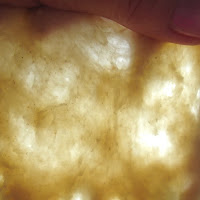
I have been making my own bread for two or three years now. I love bread making and I love home made bread. Wholemeal flour has been causing me endless problems as I could never get the lightness and softness i wanted. I usually ended up with loaves that could be used in the building trade. I bought the River cottage bread book recently. That book was quite a revelation to me. Unlike some bread book authors Daniel Stevens has a very laid back approach. This book slid the last piece of the puzzle in. I haven't had a failure in bread since. I used his overnight sponge method for this wholemeal loaf and two rises plus the final proof. Voila it worked perfectly. Light soft wholemeal bread. You can make it the quick route but I haven't tried it that way yet so pleased am I with the results so far.

I always add seeds to my wholemeal bread. Tiny packets full of all the essential nutrients of life. The plant goes to great effort in producing and protecting its seed, filling each genetic packet with high concentrations of vitamins, minerals, proteins, essential oils and dormant enzymes. The problem with seeds especially flax which is the most nutritious of the seeds is, if they are not chewed the nutrients are lost to you. I whizz my seeds in the food processor so nothing is lost then just add a couple of tablespoonfuls to the mix before kneading.

It always amuses me when watching a movie when a breakfast time scene is shown. Mum is standing perfectly coiffed and suited having a final cup of coffee before departing for her high powered job while hubby and kids are all seated round the table eating different breakfasts from pancakes to eggs. Mum must be up at four in the morning to accomplish that lot. The reality is somewhat different. Breakfast is a rushed affair. Mum making sure all is ready for the children before going to school or singles would rather grab an extra ten minutes in bed than take breakfast. This bread toasted at least gives you a nutritious start to the day even if it is taken on the run. It also makes lovely sandwiches so no problems at lunch time either.
I have added some bread making tips. I don't set myself up as an expert, far from it but I have noticed a lot of people are afraid to use yeast. I was the same when I started. I think there are a lot of books which are very precise in instructions and advice conflicts from book to book. Perhaps because the authors are masters of their trade I don't know. Anyway I thought as an everyday home baker I would pass on what experience I have and a few tips I have picked up along the way in the hope it will encourage the fearful to take the plunge.
Oatie Wholemeal Loaf
500gms/18oz Wholemeal flour
300 mls water (warm if going the quick route) or 150 mls milk and 150 mls water
1 teaspoon instant yeast
1-2 teaspoons salt
About 1 tablespoon oil (optional)
Extras
2 tablespoons seeds
1 tablespoon honey
You can also add a handful of raisins or other dried fruit to this but it does make the bread quite sweet so you may want to leave out the honey.
I have started using baker's percentages which makes adjusting amounts of ingredients very simple.
The basic mix is
Flour =100%
Liquid = 60%
Dried InstantYeast = 1% (or 2% if using fresh yeast)
Salt = 2%
Fat = 2 %
(The fat can be oil,butter or lard and is optional. The salt can be varied according to taste.)
You use whatever flour you wish or a mix of flours
After this you have your extras such as seeds, honey, or whatever you want to use. If adding dry extras to the mix you may need a little extra liquid. I add soya flour and horlicks to my white bread to assist the growing bones of my little people so I need to add more liquid.
I base most of my tin breads on 500 gms flour. It suits the fairly large loaf tins I use
Because the basic recipe uses instant dried yeast you can of course just chuck everything into the bowl and knead. I am just giving instructions for the sponge method because it is a slightly different route. Not essential at all. It does however allow you time. That is, if you have a day at home you can do this and leave it until it suits you to make the bread. The same applies to the second or even third rise. If you have to dash off and it doesn't suit to make the bread you can leave it to rise again and gain some time. It does of course improve the bread too.
Sponge Method.
This can be done overnight or for just a few hours or even one makes a difference,
Mix half of the flour, all of the yeast and all of the liquid. Make sure it is thoroughly mixed then cover with cling film and forget about it until you are ready for the next stage.

It will look quite bubbly and frothy now.
Add the rest of your flour fat (if using) salt and any extras. Mix thoroughly. If you find the dough is a little dry, add a more liquid a tablespoon at a time. You don't want it to be a sticky mess. If it does you can add a little more flour. My best guide using a dough hook is, it is right when it leaves the side of the bowl clean but is still quite soft.

Knead for ten minutes if you are doing it by hand. I use a dough hook in my stand mixer so 4-5 minutes is enough. Over kneading is not going to be a problem by hand but if using machinery it could be. The gluten structure can collapse. Keep your machine at a slow speed. If you want to test it the dough should stretch to quite a thin membrane. This is easier to see in white flour dough than wholemeal

Form it into a ball and place in a lightly oiled bowl and cover with cling film to double in volume which should take about an hour to an hour and a half depending on the temperature of the room.

I cheat a little and turn my oven on very low for a few minutes while the dough is kneading and then turn it off and pop my dough in there to rise.

When the dough is ready pull it gently out of the bowl with oiled hands onto a lightly oiled surface. The oiling stops the dough sticking to you and everything else.

The advice generally given is to punch the dough hard in the bowl to knock it back. I have found this to be the worst notion of handling dough. It is full of all the wonderful air to give the final loaf lightness. I never could understand why it had to be treated so harshly. Handling it gently makes a huge difference.
Just dimple it out with your fingers to disperse the air throughout the dough

At this stage you can form it into a ball againa give it a second rise. It is not essential but it does improve the dough so if you have the time and inclination you can do so. A lot of people fear that the yeast will lose it's 'power'. It doesn't. You can try a little experiment if you are not convinced. Mix 100 gms/4oz of flour with 60 mls of water and a little yeast. Leave it in a covered plastic box . Every so often squash it back. Just watch how often it pushes the lid off the box. It goes on for days.
Now you want to shape the dough for it's final rise or proof. You want to decide at this stage whether you want to make a tin loaf or place it on a baking tray (or stone if you have one) for a more rustic shape. Fold the dough over towards you firming each fold with your thumbs as you go.

Flatten the sausage and fold it in on itself like a business letter

Then you need to pull the sides up to the middle. This creates a surface tension on the top of the dough. It can be fiddly at the start but you soon find your own way of going. Don't worry the dough won't spoil as you work with it. Just take your time.

When you have it all pinched together on the underside turn it over and tighten gently across the surface on either side.

This leaves you with a a sort of cylinder shape. At this stage you want to add any coatings. I like to just dust it over with flour. Rye flour gives a nice rustic look. For the oat coating, dip the loaf in milk and then roll in a mix of oat flakes oat bran and pin head oatmeal. Press it quite firmly on all over so they stay in and on the loaf and don't end up on the floor when you come to use it. Now if you want to make a tin bread make sure the cylinder is about the same length and width as you chosen tin. Just press it gently into the prepared tin for it's final proof. If you want a rustic bread shape place it on a baking sheet.

Enclose the loaf in a plastic bag. This gives a nice moist draught free environment in which to rise. Some like to use towels but I find them difficult to keep off the surface of the bread and they also absorb the moisture.

Tuck in the ends of the bag and leave it in a warm place to rise. I usually turn my oven on at this point for baking the bread and leave the loaf to rise on the hob for about 20-40 minutes. After about twenty minutes shake it very very gently and you will feel how light it is getting. At the point it is ready for the oven it is really very trembly. You will feel it. I find it ready at about 40 minutes. Now you want to slash the loaf diagonally across the top to allow it to expand in the oven. I use a bread knife for this.

Place an old roasting tin in the bottom of the oven while it is heating and boil the kettle. The addition of hot water in the oven gives a nice steamy environment for the bread. Again it is not essential but does improve the crust
Have your oven turned up to about twenty degrees hotter than you need it. This will give you time to get the loaf in, pour the boiling water into the tin, without losing too much heat.
Then turn the heat down. I bake my loaves at 180.C Fan and that suits them perfectly but there are variations in every oven. 200.C/180'CFan/400.F/Gas6 is about the norm. It should take about 35 -45 minutes to bake. After 35 mins remove from the oven and tap the bottom of the loaf. It should sound quite hollow. If you are not sure pop it back in the oven for five minutes and so on. You don't want a doughy crumb. If you find your loaf too brown when ready, that is on the point of burn, the next time turn your oven down a bit. You will soon find what is best for you and your oven.
Place the loaf on a cooling rack and leave it until cool completely before cutting. Cutting it warm just gives a doughiness which spoils the bread.





You could also check out Yeast Spotting for some great recipes and information on bread









12 comments:
What magnificent loaves! Thta bread sounds really interesting!
Cheers,
Rosa
The loaves look tasty and the tips are excellent. Thanks Brenda.
Dear Brenda your bread look amazing!!! I love make bread Really nice, and good tips!! thanks, xxgloria
Lovely bread Brenda.
Brenda, excellent tutorial.
I'll keep in mind your tips.
xxx C
Thank you for your excellent advice. Your breads are outstanding.
What a lovely helpful post, thank you! I too have started to make my own bread over the past year or so, and am probably having more successes than failures now! It's always good to hear how other people make their bread, especially when it comes out as well as yours does - I love the crumb of your loaves!
What an interesting and informative post - I just learned a lot about bread making. I love wholemeal bread, it's my favourite, but I haven't made any yet. White bread rolls are my usual, but I'd like to branch out a bit.
Btw, I am that immaculately dressed and coiffed mother from the movies who whips up pancakes every morning (yeah, right - I'm actually the mother who stays in bed an extra 15 mins while the children feed themselves cereals!)
I love to add seeds to bread, too. It adds so much flavor to a bread, espeically when the seeds are toasted before adding. Your breads look delicious.
Thank you everyone for your comments. I was unsure whether to post this as I didn't want to come across as 'know it all' Making my own bread two or three times a week has given me experience but does not make me an expert in any way. There is always something new to learn. I am hoping for some more tips from bread makers who pop in :)
Stefanie - I never thought about toasting the seeds. I shall try
that.
Arista One of the joys of retirement is I can start my day with a couple of mugs of tea and have my breakfast when I want.
Carlotta gave a good tip 'off blog' that when grinding seeds freeze them first as it stops the oil from leaking. Thank you for that
C I had a look at your blog and it looks lovely. I am following it now and will be back.
You know I've been trying to master bread making Granny and this is so useful. Thanks for sharing. I've been ill for a few weeks but hope to be back in form soon and get back to it to try out these tips.
Brenda, this is a really excellent bread lesson. I especially like the percentages! Makes much more sense.
Post a Comment